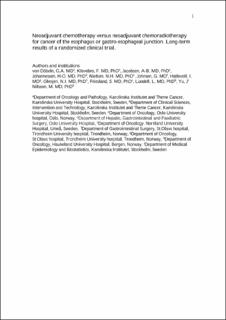| dc.contributor.author | von Döbeln, Gabriella Alexandersson | |
| dc.contributor.author | Klevebro, Fredrik | |
| dc.contributor.author | Jacobsen, Anne-Birgitte | |
| dc.contributor.author | Johannessen, Hans Olaf | |
| dc.contributor.author | Nielsen, Niels Hilmer | |
| dc.contributor.author | Johnsen, Gjermund | |
| dc.contributor.author | Hatlevoll, Ingunn | |
| dc.contributor.author | Glenjen, Nils | |
| dc.contributor.author | Friesland, Signe | |
| dc.contributor.author | Lundell, Lars R. | |
| dc.contributor.author | Yu, Jingru | |
| dc.contributor.author | Nilsson, Magnus | |
| dc.date.accessioned | 2023-02-06T14:11:52Z | |
| dc.date.available | 2023-02-06T14:11:52Z | |
| dc.date.created | 2019-04-17T16:44:57Z | |
| dc.date.issued | 2019 | |
| dc.identifier.citation | Diseases of the esophagus. 2019, 32 (2), 1-11. | en_US |
| dc.identifier.issn | 1120-8694 | |
| dc.identifier.uri | https://hdl.handle.net/11250/3048635 | |
| dc.description.abstract | NeoRes I is a randomized phase II trial comparing neoadjuvant chemoradiotherapy with neoadjuvant chemotherapy in the treatment of resectable cancer of the esophagus or gastroesophageal junction. Patients with biopsy-proven adenocarcinoma or squamous cell carcinoma, T1N1 or T2-3N0-1 and M0-M1a (AJCC 6th ed.), were randomized to receive three 3-weekly cycles of cisplatin 100 mg/m2 day 1 and fluorouracil 750 mg/m2/24 hours, days 1–5 with or without the addition of concurrent radiotherapy 40 Gy, 2 Gy/fraction, 5 days a week, followed by esophageal resection with two-field lymphadenectomy. Primary endpoint was complete histopathological response rate in the primary tumor. Survival and recurrence patterns were evaluated as secondary endpoints. Between 2006 and 2013, 181 patients were enrolled in Sweden and Norway. All three chemotherapy cycles were delivered to 73% of the patients allocated to chemoradiotherapy and to 86% of the patients allocated to chemotherapy. 87% of those allocated to chemoradiotherapy received full dose radiotherapy. 87% in the chemoradiotherapy group and 86% in the chemotherapy group underwent tumor resection. Initial results showed that patients allocated to chemoradiotherapy more often responded with complete histopathological response in the primary tumor (28% vs. 9%). Treatment-related complications were similar between the groups although postoperative complications were more severe in the chemoradiotherapy group. This article reports the long-term results. Five-year progression-free survival was 38.9% (95% CI 28.9%–48.8%) in the chemoradiotherapy group versus 33.0% (95% CI 23.6%–42.7%) in the chemotherapy group, P = 0.82. Five-year overall survival was 42.2% (95% CI 31.9%–52.1%) versus 39.6% (95% CI 29.5%–49.4%), P = 0.60. There were no differences in recurrence patterns between the treatment groups. This is to our knowledge that the largest completed randomized trial comparing neoadjuvant chemotherapy with neoadjuvant chemoradiotherapy followed by esophageal resection in patients with cancer in the esophagus or gastroesophageal junction. Despite a higher tumor tissue response in those who received neoadjuvant chemoradiotherapy, no survival advantages were seen. Consequently, the results do not support unselected addition of radiotherapy to neoadjuvant chemotherapy as a standard of care in patients with resectable esophageal cancer. | en_US |
| dc.language.iso | eng | en_US |
| dc.publisher | Oxford University Press | en_US |
| dc.title | Neoadjuvant chemotherapy versus neoadjuvant chemoradiotherapy for cancer of the esophagus or gastroesophageal junction: long-term results of a randomized clinical trial | en_US |
| dc.type | Peer reviewed | en_US |
| dc.type | Journal article | en_US |
| dc.description.version | acceptedVersion | en_US |
| dc.source.pagenumber | 1-11 | en_US |
| dc.source.volume | 32 | en_US |
| dc.source.journal | Diseases of the esophagus | en_US |
| dc.source.issue | 2 | en_US |
| dc.identifier.doi | 10.1093/dote/doy078 | |
| dc.identifier.cristin | 1693089 | |
| cristin.unitcode | 1920,2,0,0 | |
| cristin.unitcode | 1920,12,0,0 | |
| cristin.unitname | Kirurgisk klinikk | |
| cristin.unitname | Kreftklinikken | |
| cristin.ispublished | true | |
| cristin.fulltext | postprint | |
| cristin.qualitycode | 1 | |
